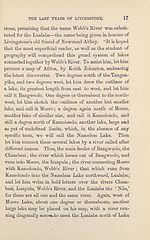Download files
Complete book:
Individual page:
Thumbnail gallery: Grid view | List view

16
THE LAST TEARS OF LIVINGSTONE.
ingstone astray, and therefore he did not pay ranch atten¬
tion to it, as he regard«d the former simply as the head¬
waters of the latter. From the beginning of 1867 until
he arrived atUjiji in March, 1869, he was engaged for the
most part in correcting the errors of previous travellers,
especially the'Portuguese, who had caused considerable
confusion by speaking of the two rivers as if they were
identical. In exposing these errors, Livingstone traversed
and re-traversed the valley of the Chamhezi until he found
it emptying itself into Lake Bangweolo—its direction be¬
ing north and west. It was, therefore, clearly shown that
Chambezi was a distinct river from the Zambesi, and, as
the traveller contended, none other than the most south¬
erly feeder of the Nile The real name of the Zambesi,
moreover, he found to he Domhazi. North-west of Ca-
zemhe’s country,' the traveller came to a lake called
Liemba by the natives, hut which was ascertained to be
the lower end of Tanganyika, in latitude' nine degrees
south. Its entire length, therefore, would be 560 geogra¬
phical miles. We axe now in a position to consider the
conclusions to which Livingstone came regarding the
water-system. These were in brief, that the lake and
river-system beginning with Tanganyika and passing
through the Victoria and Albert Nyanza, were not the ul¬
timate sources of the Nile; and that the parallel system from
the Chambezi was the true river. The remaining years
of Dr. Livingstone’s life were spent in verifying his view
of the hydrography of Central Africa. We may here in¬
sert the lucid explanation Stanley obtained from Living-
THE LAST TEARS OF LIVINGSTONE.
ingstone astray, and therefore he did not pay ranch atten¬
tion to it, as he regard«d the former simply as the head¬
waters of the latter. From the beginning of 1867 until
he arrived atUjiji in March, 1869, he was engaged for the
most part in correcting the errors of previous travellers,
especially the'Portuguese, who had caused considerable
confusion by speaking of the two rivers as if they were
identical. In exposing these errors, Livingstone traversed
and re-traversed the valley of the Chamhezi until he found
it emptying itself into Lake Bangweolo—its direction be¬
ing north and west. It was, therefore, clearly shown that
Chambezi was a distinct river from the Zambesi, and, as
the traveller contended, none other than the most south¬
erly feeder of the Nile The real name of the Zambesi,
moreover, he found to he Domhazi. North-west of Ca-
zemhe’s country,' the traveller came to a lake called
Liemba by the natives, hut which was ascertained to be
the lower end of Tanganyika, in latitude' nine degrees
south. Its entire length, therefore, would be 560 geogra¬
phical miles. We axe now in a position to consider the
conclusions to which Livingstone came regarding the
water-system. These were in brief, that the lake and
river-system beginning with Tanganyika and passing
through the Victoria and Albert Nyanza, were not the ul¬
timate sources of the Nile; and that the parallel system from
the Chambezi was the true river. The remaining years
of Dr. Livingstone’s life were spent in verifying his view
of the hydrography of Central Africa. We may here in¬
sert the lucid explanation Stanley obtained from Living-
Set display mode to:
![]() Universal Viewer |
Universal Viewer | ![]() Mirador |
Large image | Transcription
Mirador |
Large image | Transcription
| Antiquarian books of Scotland > Scotland/Scots > Last years of Livingstone > (24) |
|---|
| Permanent URL | https://digital.nls.uk/136057450 |
|---|
| Description | Thousands of printed books from the Antiquarian Books of Scotland collection which dates from 1641 to the 1980s. The collection consists of 14,800 books which were published in Scotland or have a Scottish connection, e.g. through the author, printer or owner. Subjects covered include sport, education, diseases, adventure, occupations, Jacobites, politics and religion. Among the 29 languages represented are English, Gaelic, Italian, French, Russian and Swedish. |
|---|

